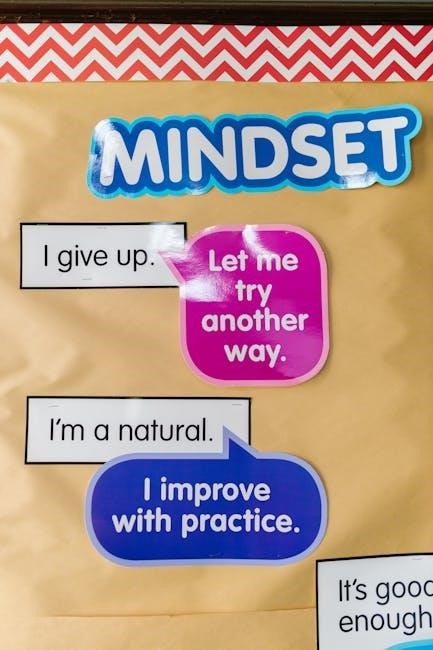Solving Equations with Variables on Both Sides: A Comprehensive Guide with Worksheets
This guide offers a comprehensive exploration of solving equations where variables appear on both sides․ We provide clear methods, step-by-step instructions, and downloadable PDF worksheets․ These resources include practice problems, answer keys, and various challenge levels for effective learning and skill enhancement in algebra․
Welcome to the world of algebraic equations! In this section, we’ll introduce the fundamental concepts behind solving equations where variables appear on both sides of the equals sign․ This skill is crucial for success in algebra and beyond, as it forms the basis for more complex problem-solving․
These equations require a different approach than simple one- or two-step equations․ The key is to manipulate the equation strategically to isolate the variable on one side․ This involves using inverse operations, combining like terms, and maintaining balance by performing the same operation on both sides․
We’ll explore why this skill is essential and lay the groundwork for the techniques you’ll learn in subsequent sections․ Whether you’re a student learning algebra for the first time or someone looking to brush up on your skills, this introduction will provide a solid foundation for mastering equations with variables on both sides․ Get ready to tackle these problems with confidence! We also provide solving equations with variables on both sides worksheets pdf․
Simplifying Expressions on Each Side
Before we dive into isolating variables, it’s crucial to simplify each side of the equation individually․ This involves identifying and combining like terms, as well as applying the distributive property if parentheses are present․ Simplifying makes the equation easier to manage and reduces the chances of errors․
Look for terms that have the same variable raised to the same power․ These can be combined by adding or subtracting their coefficients․ For example, in the expression “3x + 5 ─ x + 2,” you can combine “3x” and “-x” to get “2x,” and “5” and “2” to get “7,” resulting in the simplified expression “2x + 7․”
If you encounter parentheses, remember to distribute any coefficients or constants outside the parentheses to each term inside․ For instance, “2(x + 3)” becomes “2x + 6․” By systematically simplifying each side, you’ll set yourself up for a smoother solution process․ Simplifying each side is an important first step, we also offer solving equations with variables on both sides worksheets pdf․
Combining Like Terms
Once each side of the equation is simplified, the next step is to combine like terms wherever possible․ Like terms are terms that contain the same variable raised to the same power․ Combining them involves adding or subtracting their coefficients while keeping the variable and its exponent the same․
For example, consider the expression “5x + 3 ─ 2x + 7․” Here, “5x” and “-2x” are like terms, as are “3” and “7․” Combining them yields “3x + 10․” This process reduces the number of terms, making the equation more manageable․
Pay close attention to the signs of the coefficients․ A negative sign in front of a term means you are subtracting that term․ Remember that constants are also like terms, so combine them accordingly․ This step is crucial for simplifying equations and setting the stage for isolating the variable․ Our solving equations with variables on both sides worksheets pdf can help․
Isolating the Variable Term
After combining like terms, the next crucial step involves isolating the variable term on one side of the equation․ This means getting the term containing the variable by itself, with no other constants or terms added to or subtracted from it on that side․
To achieve this, we utilize inverse operations․ If a constant is added to the variable term, subtract that constant from both sides of the equation․ Conversely, if a constant is subtracted from the variable term, add that constant to both sides․ Remember, maintaining balance is key; whatever operation you perform on one side, you must also perform on the other․
For example, if you have the equation “3x + 5 = 14,” you would subtract 5 from both sides to isolate the variable term: “3x = 9․” This step simplifies the equation further, bringing you closer to solving for the variable․ Practice this step with our solving equations with variables on both sides worksheets pdf․
Using Inverse Operations
Once the variable term is isolated, the final step in solving the equation involves using inverse operations to solve for the variable itself․ This means undoing any operation that is being applied to the variable, such as multiplication or division․
If the variable is being multiplied by a coefficient, divide both sides of the equation by that coefficient․ Conversely, if the variable is being divided by a number, multiply both sides of the equation by that number․ The goal is to get the variable completely alone on one side of the equation, with a coefficient of 1․
For example, if you have the equation “3x = 9,” you would divide both sides by 3 to solve for x: “x = 3․” This final step reveals the value of the variable that satisfies the original equation․ You can find more practice problems in our solving equations with variables on both sides worksheets pdf․
Solving Multi-Step Equations with Variables on Both Sides
Multi-step equations combine several operations, demanding a strategic approach․ Solving these equations involves simplifying each side by combining like terms and using the distributive property when needed․ Once simplified, the goal is to isolate the variable on one side of the equation․ This requires careful application of inverse operations to both sides, ensuring the equation remains balanced․
For instance, you might encounter an equation like 2(x + 3) ౼ 5x = 4 ౼ x․ First, distribute the 2, combine like terms, and then move all the variable terms to one side and constants to the other․ Continue using inverse operations to isolate x․
Mastering multi-step equations is essential for advanced algebra․ Our solving equations with variables on both sides worksheets pdf include numerous examples and practice problems to help you develop proficiency in this skill․ With consistent practice, you’ll confidently tackle even the most complex equations․
Dealing with Distributive Property
The distributive property is a fundamental concept when solving equations, especially those with variables on both sides․ This property allows you to eliminate parentheses by multiplying a term outside the parentheses by each term inside․ Failing to apply the distributive property correctly can lead to incorrect solutions, so mastering it is essential․
Consider an equation like 3(2x ─ 5) = 4x + 7․ The first step is to distribute the 3 across the terms inside the parentheses, resulting in 6x ౼ 15 = 4x + 7․ From there, you can proceed to combine like terms and isolate the variable․
Our solving equations with variables on both sides worksheets pdf provide ample opportunities to practice using the distributive property in various equation formats․ These worksheets progressively increase in difficulty, helping you build a solid understanding of how to apply the distributive property effectively․ With consistent practice, you’ll confidently tackle equations involving distribution․
Fractions and Decimals in Equations
Equations containing fractions and decimals can initially seem daunting, but they are manageable with the right strategies․ One common approach is to eliminate fractions by multiplying every term in the equation by the least common denominator (LCD)․ This simplifies the equation, making it easier to solve for the variable․
For example, in the equation (1/2)x + 3 = (2/3)x ౼ 1, the LCD of 2 and 3 is 6․ Multiplying each term by 6 transforms the equation to 3x + 18 = 4x ─ 6, which is much simpler to solve․
Similarly, decimals can be eliminated by multiplying all terms by a power of 10 that shifts the decimal point to the right, creating whole numbers․
Our “solving equations with variables on both sides worksheets pdf” offer extensive practice in dealing with fractions and decimals․ These worksheets provide a variety of equations, ranging from basic to advanced, that will help you become proficient in these techniques․ Each worksheet includes answer keys, allowing you to check your work and reinforce your understanding․
Checking Your Solution
After solving an equation with variables on both sides, it’s crucial to verify the solution․ Checking ensures that the value obtained for the variable satisfies the original equation, preventing errors and reinforcing comprehension․ This process involves substituting the calculated value back into the original equation․
If the left-hand side (LHS) equals the right-hand side (RHS) after substitution, the solution is correct․ If the LHS and RHS are not equal, an error occurred during the solving process․ In such cases, it is necessary to review each step to identify and correct the mistake․ Checking solutions not only validates answers but also enhances problem-solving skills and accuracy․
Our “solving equations with variables on both sides worksheets pdf” include dedicated sections that emphasize the importance of checking solutions․ Each worksheet provides space for students to perform the check, encouraging them to adopt this practice as a standard part of their problem-solving routine․
Detailed answer keys are also provided, allowing learners to compare their checking process and results with the correct solution, further solidifying their understanding and confidence․
Applications of Solving Equations with Variables on Both Sides
Solving equations with variables on both sides is a fundamental skill with wide-ranging applications across various fields․ In mathematics, it forms the basis for more advanced algebraic concepts․ Beyond the classroom, this skill is crucial in everyday problem-solving, financial planning, and scientific analysis․
For instance, consider a scenario where you need to compare costs from two different service providers with varying pricing structures․ Setting up an equation with variables on both sides can help determine the point at which one provider becomes more cost-effective than the other․ Similarly, in physics, these equations are used to model relationships between forces, motion, and energy․
In business, understanding how to solve these equations is essential for calculating break-even points, analyzing profit margins, and making informed investment decisions․ Our “solving equations with variables on both sides worksheets pdf” include real-world application problems that demonstrate the practical relevance of this skill․ These problems cover scenarios from simple budgeting to more complex financial analyses, helping students appreciate the utility of algebra in their lives․
By mastering this skill, learners gain a valuable tool for critical thinking and problem-solving in diverse contexts․
Worksheet Resources and Practice Problems
To solidify your understanding and enhance your skills in solving equations with variables on both sides, we provide a comprehensive collection of worksheet resources and practice problems․ These materials are designed to cater to various skill levels, ensuring a progressive learning experience․ Our “solving equations with variables on both sides worksheets pdf” offer a wide array of exercises, from basic introductory problems to more challenging multi-step equations․
Each worksheet is carefully crafted to reinforce key concepts, such as combining like terms, applying the distributive property, and using inverse operations․ To aid in self-assessment, detailed answer keys are included, allowing learners to check their work and identify areas where they may need additional practice․
Furthermore, our resources incorporate word problems that translate real-world scenarios into algebraic equations․ These practical applications help students understand the relevance of solving equations in everyday contexts․ The worksheets are available in PDF format for easy download and printing, making them accessible for both classroom and home use; Whether you are a student looking to improve your algebra skills or a teacher seeking supplementary materials, our worksheet resources and practice problems provide valuable tools for mastering equations with variables on both sides․


